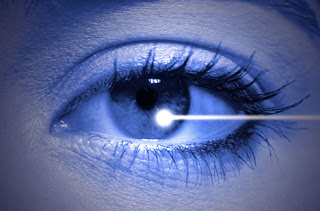views the best pictures
Many people are talking about LASIK this and LASIK that, but you don't understand what LASIK is? If you are wearing contact lenses or glasses, probably you might be interested in LASIK. LASIK is an acronym for Laser Assisted In Situ Keratomileusis. It is a type of eye surgery to reshape cornea and improve your visual acuity. With LASIK eye surgery, many people have achieved better vision without having to wear glasses or contact lenses. LASIK eye surgery uses laser beams to remove the corneal tissue without disturbing nearby cells. Before that, a hinged corneal flap is created with microkeratome blade or laser (IntraLase method) and after the underlying corneal tissue has been removed, the corneal flap is repositioned. The flap will stick to the underlying cornea on its own and heals quickly. It is a painless procedure because the LASIK surgeon will use anesthetic eye drops to numb your eye. You may feel a little uncomfortable because your eyelids are secured with a small instrument to keep your eye wide open during the LASIK eye surgery.
LASIK eye surgery uses laser beams to remove the corneal tissue without disturbing nearby cells. Before that, a hinged corneal flap is created with microkeratome blade or laser (IntraLase method) and after the underlying corneal tissue has been removed, the corneal flap is repositioned. The flap will stick to the underlying cornea on its own and heals quickly. It is a painless procedure because the LASIK surgeon will use anesthetic eye drops to numb your eye. You may feel a little uncomfortable because your eyelids are secured with a small instrument to keep your eye wide open during the LASIK eye surgery.LASIK eye surgery has been the most popular eye surgery these days because the cornea healing with LASIK procedure is faster and less painful than other eye surgeries, such as PRK (Photo Refractive Keratectomy). It has been performed on more than one million people in the world. In the United States, the practice of LASIK surgery is regulated by the U.S. Food and Drug Administration (FDA), including the approval of all medical devices used for the procedure, especially the lasers used for LASIK. However, FDS does not have the authority to set the price for LASIK, recommend any LASIK surgeons or clinics or laser centers or provide ratings of lasers approved for the LASIK procedure.
However, not every eye problems can be treated with LASIK eye surgery. LASIK eye surgery is for people with common vision problems as follows:
- Nearsightedness (myopia)
People who are near-sighted are only able to clearly see things near them and things that are far away may seem blur to them.
- Farsightedness (hyperopia)
People who are far-sighted cannot see near things clearly but able to see clearly things that are far away.
- Astigmatism
People with astigmatism are difficult to see things clearly at any distance because of irregularities in the cornea or the lens of the eye.
It can also treat people with a combination of above problems, such as myopia and astigmatism or hyperopia and astigmatism.
LASIK cannot correct or prevent presbyopia, which is a type of vision problem in people at the age of 40 or older. This means that if you have had LASIK surgery, you still have to wear bifocal glasses when you already have presbyopia.
So, if you are really interested in LASIK to eliminate your dependence on glasses or contact lenses, consult with your doctor to determine if you are eligible for LASIK or not and make sure you know the risks and complications that LASIK eye surgery may cause. Comprehensive eye examinations, using a number of medical equipments will be taken and a few questions will be asked before you can undergo LASIK.
by: Lina Lee
Article Source : An Overview of LASIK Eye Surgery
No comments:
Post a Comment